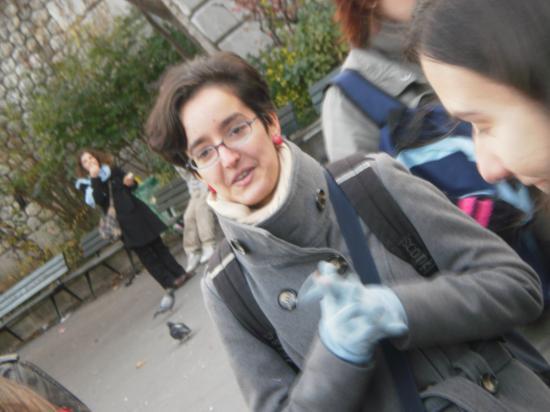Square Willette et Parvis Sacré Ceur
Après une course folle à suivre le carnet rouge à travers la foule (et quelque tentative de vol envers Audrey), nous arrivâmes, bien vivants, et tous présents, au square Willette, que nous présenta Anne avec le Parvis du Sacré Coeur 
1.The “butte
There are several points of interest, which represent the identity of Montmartre.
-Montmartre is a hill which is
-It is famous thanks to the basilica of the Sacré Coeur, we have to keep in mind that this place was very early a religious place.
-Montmarte is a synonym of painting: it is very famous because of the numerous artists who worked here and who still work here for exemple in the Tertre Square.
-Montmartre is also a very popular place where inhabitants of Paris meet each other, for exemple in the Marché St Pierre, where you can find a lot of different types of fabrics.
2.The Willette Garden
-It’s a garden of
-The name of this garden refers to Adolphe Léon Willette, a French paintor, an illustrator and a caricaturist of the XIXth c. He lived in
But in 2004, the name of the garden changed and became square Louise Michel, because Willette was known as an anti-Semite. Louise Michel was an anarchistic woman who played a great part in the Paris Commune in 1870.
The square was conceived acording to the hilly landscape; the stairs put the Sacré Coeur in perspective and they emphasize it.
3.The fountain
The monumental fountain was created by Paul Gasq in 1932. It is composed of three basins carried by the Ocean Gods.
The stone used for the fountains and the stairs, as well as for the Sacre Coeur basilica, releases calcium when it rains. It’s a white substance, which resists pollution and gives the everlasting white appearance.
At the beginning of the 19th century, zoologist Georges Cuvier discovered fossils of more than 43 million years old encrusted in fragments of gypsum. This discovery on Butte Montmartre resulted in the creation of paleontology in 1834.
4.Trees
The garden has two different sides. We have seen the first, which was very geometrical; the other looks like paths in the mountain. We can find here a great variety of trees, for example gingko biloba, magnolias, fig tree, pomegranate tree and araucarias. There is an Indian hazelnut tree,
There are also two Osage orange trees of
5.The panoramic view
Here we have a strategic point of view on


Commentaires (1)
1. Steve 30/12/2009
Youps, encore une erreur technique qui efface la moitié de ce je publie...donc voici le LEXIQUE :
Hilly landscape:[/b] relief accidenté
[b]Fabric: [/u]tissu
Pomegranate: grenade
Indian hazelnut: maronnier d’Inde
Pterocarya: ptérocarier ou noyer du Caucase
Bark :[u] écorce
Et vlà !!!